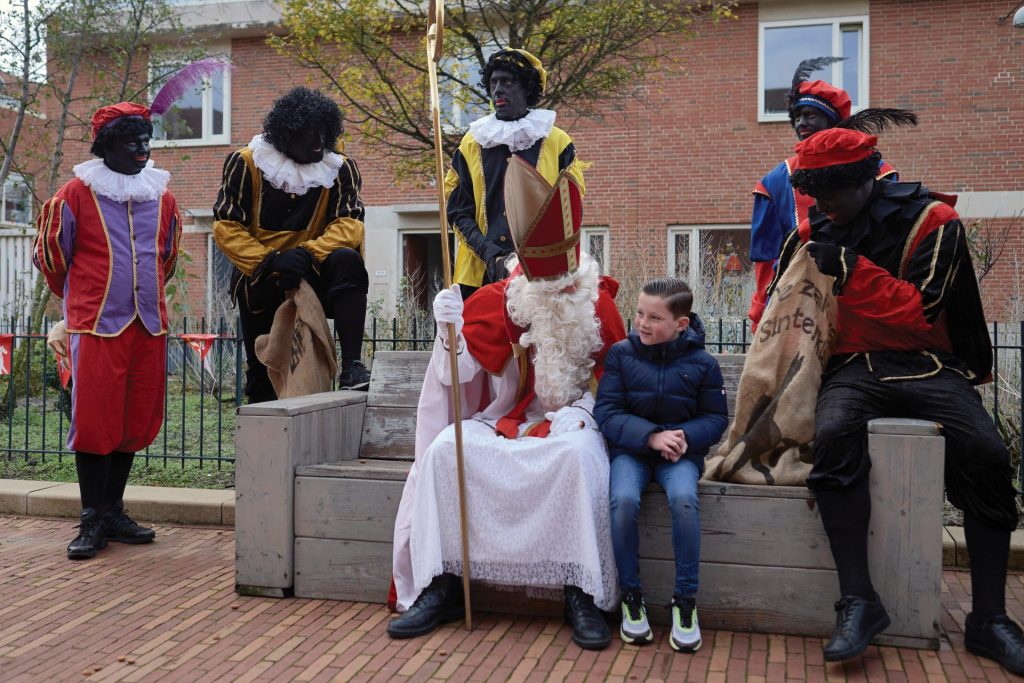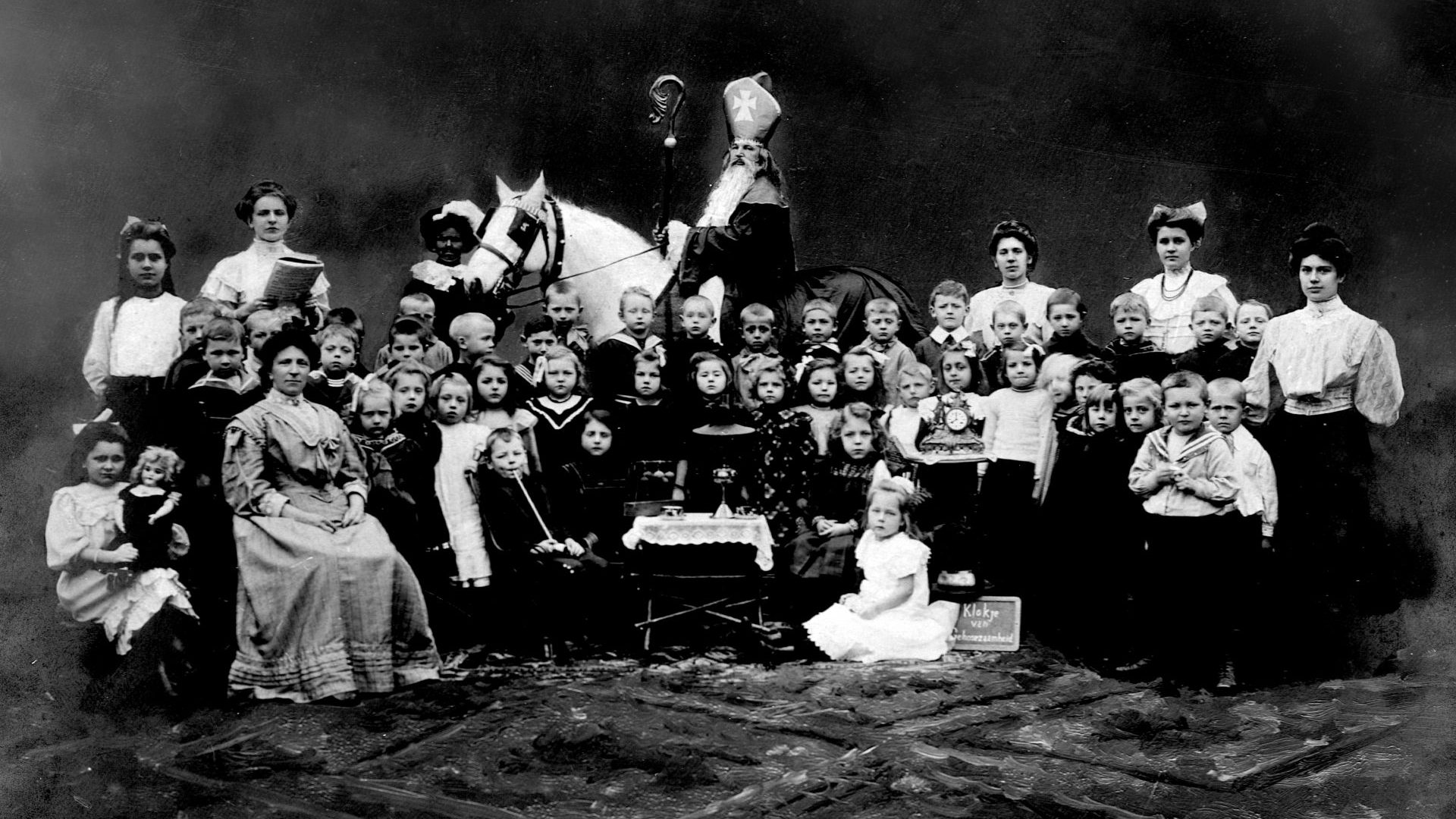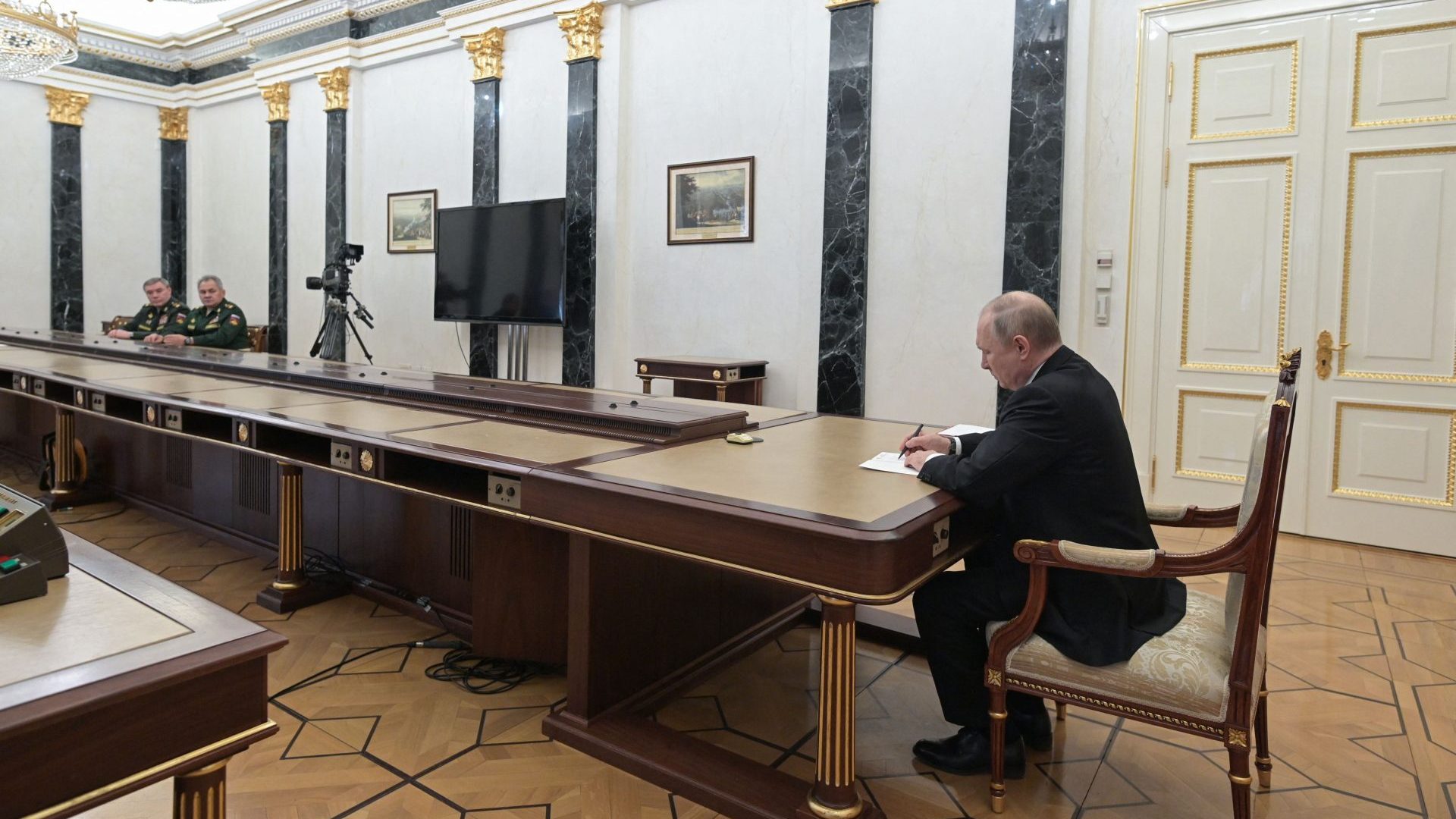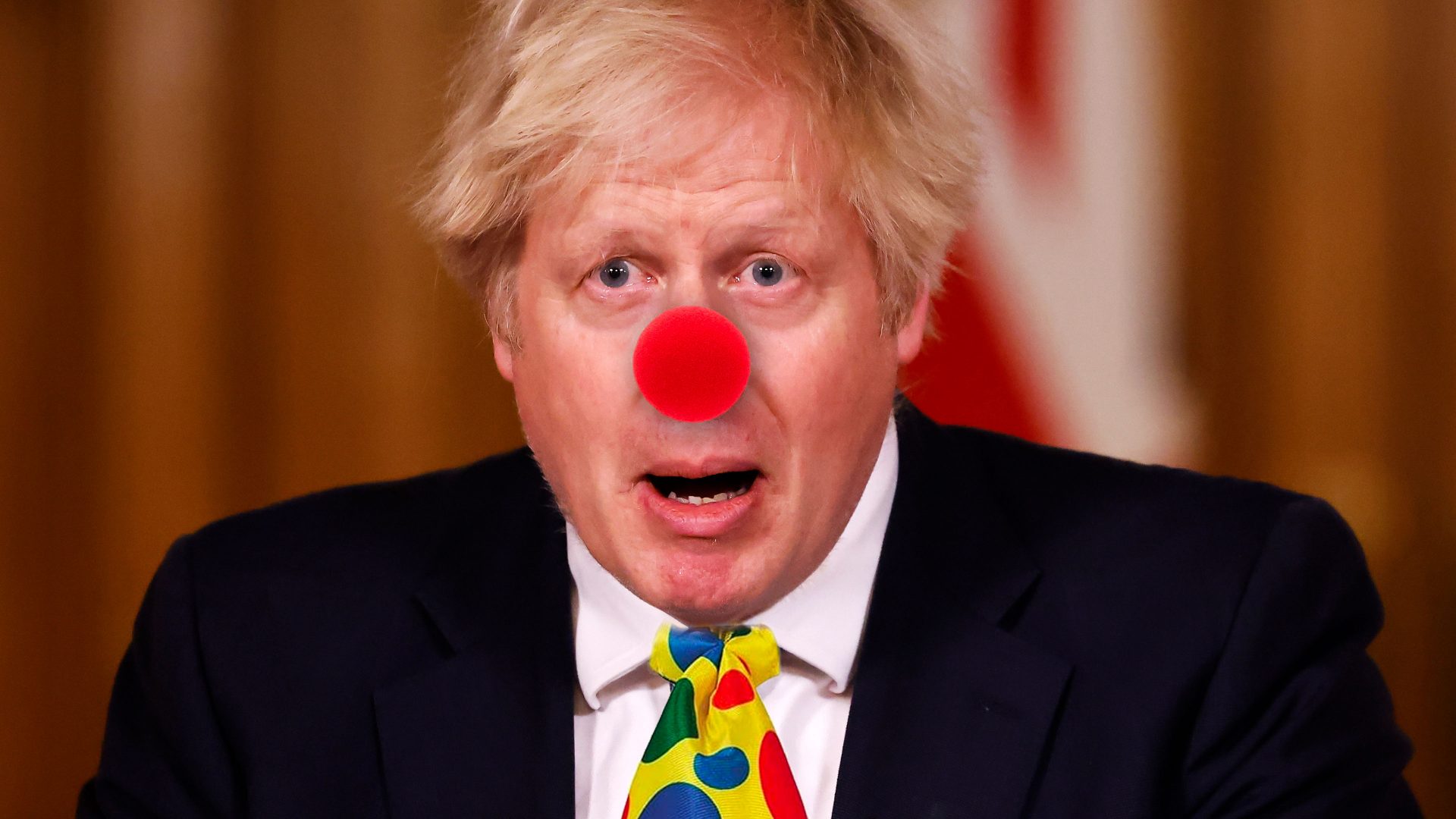As Christmas approaches, the people of the Netherlands are once again preparing for the annual St Nicholas Day holiday, when Sinterklaas will hand out sweets and toys to children. But these traditional celebrations have taken on an increasingly political and divisive tone due to his sidekick, Zwarte Piet, or “Black Pete”.
Traditionally portrayed by white people in blackface, over the last decade the figure of Piet has become a lightning rod for debates about race, the legacy of slavery and what it means to be Dutch.
Zwarte Piet first appeared in his modern form in the children’s book Sint Nicolaas en Zijn Knecht (Saint Nicholas and His Servant), written by Jan Schenkman in 1850. The schoolteacher was the man who invented Christmas for the Dutch, bringing together many pre-existing but disparate festive traditions into a unified narrative.
In Schenkman’s telling, a notably thin Saint Nicholas was a bishop from Turkey, rode a horse called Amerigo and arrived on a boat from Spain in mid-November, several weeks before his birthday celebrations on December 6, on the eve of which – Pakjesavond – he dropped presents down the chimneys of good children.
Saint Nicholas was also accompanied by Zwarte Piet, commonly considered to be a Moor. Schenkman’s book was published 13 years before slavery was abolished in Dutch colonies, and Pete reflected the racialised master-servant relationship.
Initially, Piet was a sinister figure who, parents told their children, spanked those on the naughty list with a bundle of twigs. From the 1950s onwards, his personality became less menacing. Like the black gnome “Golliwog” used as a trademark for Robertson’s jam, which, lest we forget, only disappeared from shelves in the UK in 2001, Piet appeared on food packaging. Sweets and stuffed toys were made in his image. But this was no flattering depiction. Piet had become a stupid, clumsy figure only able to speak broken Dutch, a characterisation compounded by the fact that white people began to dress as him during the Sinterklaas celebrations, with blackface makeup, curly wigs, red lips and gold earrings. A century after he entered Dutch tradition, Piet still had deeply racial connotations.
There had been challenges to this narrative since the 1930s, but none had any real impact until 1987, when the Surinamese actor Gerda Havertong, a regular on Sesamstraat, the Dutch spin-off of Sesame Street, responded to her son being called Zwarte Piet at school by writing a two-minute scene for the show. In it, she took Pino, the large, blue cousin of Big Bird, to task for using the term, explaining that “for a lot of black people, Sinterklaas is not a party at all”.
However, it was not until nearly 25 years later that the issue gained a foothold in public debate. In 2011 a similar incident prompted Quinsy Gario, an Amsterdam-based poet and dramatist, to create an art project aimed at provoking discussion about race in the Netherlands. “One day my mum was called Zwarte Piet,” says Gario, who was born in Curaçao, an island in the former Dutch Antilles. “She was a beautiful black woman in her mid-50s with greying hair, so she looked nothing like those images. The only reason that would be said would be to exclude her; to hurt her.”
At around the same time, Geert Wilders, the leader of the nationalist right wing Party for Freedom (PVV), was charged with hate speech against Muslims. In June 2011, following two trials spanning more than a year, Wilders was found not guilty. His comments were deemed to be “acceptable within the context of public debate” by a presiding judge.
“One of the things that was interesting about his acquittal was this idea of how freedom of speech in the Netherlands has become enshrined as this catch-all to say whatever you want,” says Gario.
“I started the project thinking, ‘if Wilders can say what he wants to say, I can say what I want to say’ and I can problematise what’s going on with this supposed children’s tradition. I found out fairly quickly that wasn’t the case.”
In November of that year, he and several others attended the Sinterklaas parade in Dordrecht wearing T-shirts adorned with the slogan “Zwarte Piet is Racisme”. The crowd was thousands strong, and the event was broadcast on national television. The response from the police was emphatic.
After Gario refused to take off his T-shirt, uniformed and plain-clothes police dragged him down a side street. There they pinned him to the ground, one kneeling on his neck for more than two minutes.
The mainstream media ignored the incident, but footage of Gario’s arrest filmed on a mobile went viral on YouTube. The following day in Amsterdam, five more people were arrested for emulating Gario, one of the arresting officers claiming, “Sinterklaas has rights, too”.
“These arrests happen all the time,” says Gario, referencing the death of Mitch Henriquez, a tourist from Aruba who was choked to death while being arrested by five police officers in the Hague in 2015. “I’m lucky I’m here to tell the tale.”

Three years later, the Dutch Ombudsman determined Gario’s arrest to have been both unlawful and disproportionately violent. By then, Zwarte Piet had become the subject of intense public debate, dividing the country over what it means to be Dutch. “It’s connected to thinking about what exactly the makeup of Dutch society is,” says Gario. “Who is able to talk; who is still seen as a guest, even after three generations.”
Although Gario ended his art project in November 2012, a year after his arrest, his slogan lives on. By then, Jerry Afriyie, one of those detained alongside Gario, had founded the organisation Kick Out Zwarte Piet (KOZP), an umbrella organisation for groups with similar aims.
In 2013, the issue gained international attention when the UN High Commissioner for Human Rights wrote to the Dutch government stating that Black Pete was a “living trace of past slavery”. In response, a pro-Black Pete Facebook page received 2m likes. Wilders’ party dismissed the protests as “multicultural drivel”. Not wanting to be outflanked, the country’s centre-right prime minister, Mark Rutte, said “Black Pete is black, and I cannot change that because his name is Black Pete.”
In 2017, the PVV proposed legislation that would have laid down the characteristics of Zwarte Piet in law as part of a wider move to safeguard “Dutch national identity”.
But by then, a tipping point had been reached. Amsterdam and Rotterdam banned the character from their annual parades in 2017 and 2019 respectively, replacing him with Roetpiet, “Soot Pete”, whose face is streaked with soot and who does not have racialised features.
In 2020, Facebook and Instagram announced bans on pictures of Zwarte Piet. In the same year, Rutte said that his opinion had undergone “major changes” after speaking to people with “a darker skin colour” and young children who told him they felt discriminated against (although he refused to ban it).
However, these changes have prompted a backlash. This year, the decision by the producers to withdraw the 2005 children’s film The House of Sinterklaas from circulation prompted Wilders to ask whether “we are still in charge of our country. Or are the woke freaks calling the shots?”
In November, some home fans at a match between Volendam and Utrecht defied a stadium ban to dress as Piet in blackface and displayed a banner with the stark message: “Fuck KOZP”.
Despite this, Gario is hopeful for the future. “A lot of the hostility we’ve experienced is because of the gains that have been made,” he said. “When this all started there was a poll that showed 95% of people said nothing should change, and Piet had nothing to do with racism, but recently a poll showed that 50% of people no longer celebrate this tradition, which is a huge development.
“Once someone says, ‘hey, this is connected to a system of deprivation, this is connected to a system of violence, so what are you going to do?’ most people decide, ‘you know what, it’s not worth it’.”



